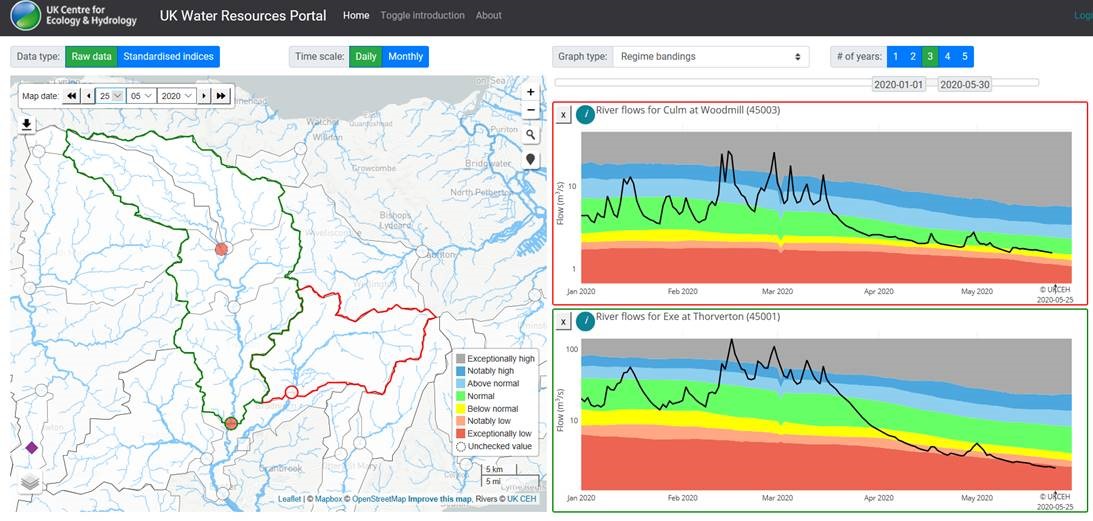The highs and lows of river flow – Connecting the Culm update
The past few months have presented new challenges for many people and communities. We were disappointed about not being able to run our planned events in March or attend community events run by others during this time. Nevertheless, we have remained busy and we’ve been adapting to working remotely and flexibly.
We welcome the positive news that the changes we and many others have made in our day-to-day lives has resulted in a dramatic reduction in greenhouse gas emissions: globally, in the UK and within Devon. There is more information about the 23% reduction in Devon’s emissions on the Devon Climate Emergency website. This shows that changes to our actions, and the infrastructure and systems we depend on, really can change quite rapidly and there is the potential to mitigate the worst effects of climate change in the future. This situation has been a tragedy in so many ways but hopefully we can take something positive from it to build a better future for ourselves and future generations.
It is important to note that we still face some degree of global heating even if we immediately transitioned to a low-carbon society. A Met Office briefing note [pdf] last year stated: “Rapid and deep cuts to emissions are essential to avoid the most dangerous impacts of change, but it is still necessary to understand and take action to adapt to the impacts we are already locked into”. We are already feeling the effects of climate change globally and locally.
Connecting the Culm is about adapting to the impacts of climate change and recently I have keenly felt the implications and challenges we face at a local level. During this particularly sunny spring – which followed a very wet winter – I have enjoyed spending time by the river near where I live during sunny lockdown walks for my daily exercise, but I have also been alarmed at the dramatic and rapid change in the river levels: from breaking its banks in storms in late February and March to remarkably low flow just a few weeks later. I have done some research using publicly available data and wanted to share some of this with you…
The UK Centre for Ecology and Hydrology has an online platform – the Water Resources Portal – which pulls together available data to show a live picture of river flows around the country. Right now, in the South West, most river flow monitoring points show ’exceptionally low’ or ’notably low’ flows. This is a dramatic change from the high flows and flooding we had during the storms and very wet winter, including the wettest February on record. This recent post on the UK Centre for Ecology and Hydrology website explores the national picture in more detail and looks at what we may face over the summer.
Flow on the River Culm is monitored at the Environment Agency gauging station at Woodmill (between Bradninch and Cullompton). If data was available for a monitoring point upstream in the Blackdown Hills (for example near Hemyock) the flow would most likely be similar to the readings at Woodmill, albeit a few hours earlier.
The colour band from dark blue to light red show typical range of flow for this period. The black line shows the actual flow this year. The graph at the top is the flow levels for the Culm, the one at the bottom is for the Exe.
These peaks in high and low flow are becoming more frequent and more extreme with climate change. The way the River Culm and its catchment responds to these extremes is what makes the Connecting the Culm project so important. This information illustrates that the way water flows through river catchments is not working. When it rains, water runs off quickly into the river and moves rapidly down, through and out of the river system. It isn’t infiltrating into the ground or being stored in the catchment as it should.
This situation can have various negative impacts for everyone. It impacts on the availability of water for farming and the resilience of our domestic water supply. Wildlife is also negatively affected with high flows impacting spawning grounds in the winter and low flow in the summer increasing vulnerability to changes in water quality. Smoothing these extremes would lead to a more resilient future for the water on which we all depend.
Interestingly, the data shows that the River Culm has a less extreme change and is perhaps slightly more resilient to low flow than other rivers in the West Country that have registered ‘exceptionally low’ readings. Perhaps this is because we have a higher proportion of mire systems in the catchment, found in the Blackdown Hills AONB near the sources of the Culm and Bolham rivers. These act as sponges and release water into the River more slowly, over a period of months not hours. The Water Resources Portal shows us that, elsewhere in the UK, rivers with different soil types and geology are more heavily influenced by groundwater, slowly releasing the rain from our wet winter into the river system. Notably some of these still have high flows despite the current dry spell.
I will leave you with a quick note about what the Connecting the Culm team has been up to:
- Technical specialists, JBA, have completed their surveys of the river and almost finished their catchment modelling to identify ways we can improve the resilience of the River Culm.
- Fjordr have also been busy and finalised their review of the historic character of the River Culm, identifying features which show how people have lived and worked with the River in the past.
- I have been working with the Westcountry Rivers Trust and our Co-Adapt project partners to manage impacts of the pandemic and get ready for the upcoming launch of our website. The website will feature much more information about the project, the various activities and findings of our work to date, why the project is needed and ways you can get involved. It will be going live in June, so watch this space!
If you want to tell us your stories of the River Culm, perhaps if you have any stories or photos from taking your exercise during the lockdown, please share these on social media (#RiverCulm #ConnectingTheCulm) / email hello@connectingtheculm. Thanks to Jeni for sharing the images below of wildlife spotted on the Culm recently!
Please complete our online survey, we are interested in your views about the River Culm, information about how you currently access the Culm, and your views on the challenges associated with the River.
To find out more about the project visit www.connectingtheculm.com








